Social Media Sentiment Analysis: Guide for 2025
Table of contents
Apple was mentioned over 659k times in the last 30 days. Your brand can be part of thousands of tiny conversations, too, and you might not even notice them. Social media sentiment analysis reads those mentions for tone, intent, and urgency in real time. So, your next move isn’t a guess and your brand reputation stays protected.
Here’s your guide to turn reactions into results in 2025 with AI sentiment analysis for social media!
- What is social media sentiment analysis?
Social media sentiment analysis uses artificial intelligence (AI) and natural language processing (NLP) to determine whether mentions of your brand on social media are positive, negative, or neutral. It automatically analyzes the emotions and opinions expressed in customer posts, comments, and reviews across different social platforms. - Why is sentiment analysis important?
Social media sentiment analysis is a valuable source of insights about your target audience’s true feelings, brand reputation, and social media performance.
What is social media sentiment analysis?
Social media sentiment analysis is the automated process of understanding how people feel about:
- Your brand overall
- A specific topic related to you
- Your brand’s recent campaign
- An event you took part in / organized
Based on their posts on social media platforms.
The analysis combines natural language processing (NLP) and machine learning techniques.
It enables tools to process social media data and determine the emotional tone and opinions of people posting the content.
Content such as posts, comments, reviews, or even untagged mentions.
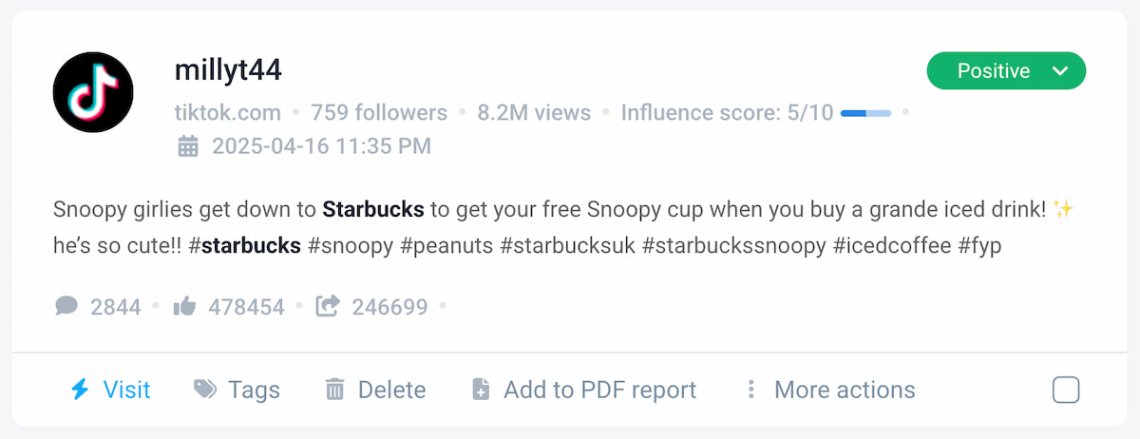
Essentially, sentiment analysis models unveil whether people’s attitudes toward a brand, topic, or event are:
- positive,
- neutral,
- or negative.
But why even bother?
The Nobel laureate of economics, Daniel Kahneman, proved that about 90% of our choices are driven by emotions.
When you combine this fact with social media platforms (that are designed to trigger our emotions), the conclusion is simple – if you care about your brand, social media sentiment analysis is a must.
💡Pro tip: Advanced social listening tools can break down these general sentiments into more specific emotions like joy, anger, or disgust, offering deeper insights into audience reactions.
Such knowledge can be priceless! Why?
Why is social media sentiment analysis important in the AI era?
According to Forrester, 71% of US consumers say that they can relate to authentic brands and therefore want to back them (data source).
AI flooding the digital space is all fun and games, but customers value real connection and want to truly be seen.
That’s why understanding your audience on a deeper, emotional level is more critical than ever.
Authenticity is just one of the possibilities the sentiment analysis creates.
Here’s a list of the main social sentiment analysis benefits.
Benefits of social media sentiment analysis:
01 Understand your performance
Sentiment analysis allows you to truly understand your social media performance.
Instead of focusing only on basic metrics like reach, clicks, or shares, you can gain insights into how people actually feel about your content strategy, campaigns, or overall brand presence.
I’ve seen it many times – reach alone might not be enough to really get where you stand in your efforts.
You might get an enormous reach in your campaign, but with negative sentiment, it won’t suggest success, but a real PR problem.
I think the well-known collab between Kendall Jenner and Coca-Cola illustrates that perfectly.
Was the campaign a hot topic? Yes.
But was it in a positive context? Absolutely not.
You should always check the sentiment to get the full picture, reach alone is not enough.
For example, the Ferrari campaign, underlining its historical legacy and being a cultural phenomenon, is exactly the opposite.
Ferrari’s target audience loves this content, and the campaign significantly impacts positive brand perception with 17% in the brand’s share of voice.
I sourced the data from Brand24. Here’s a screenshot showing the numbers:
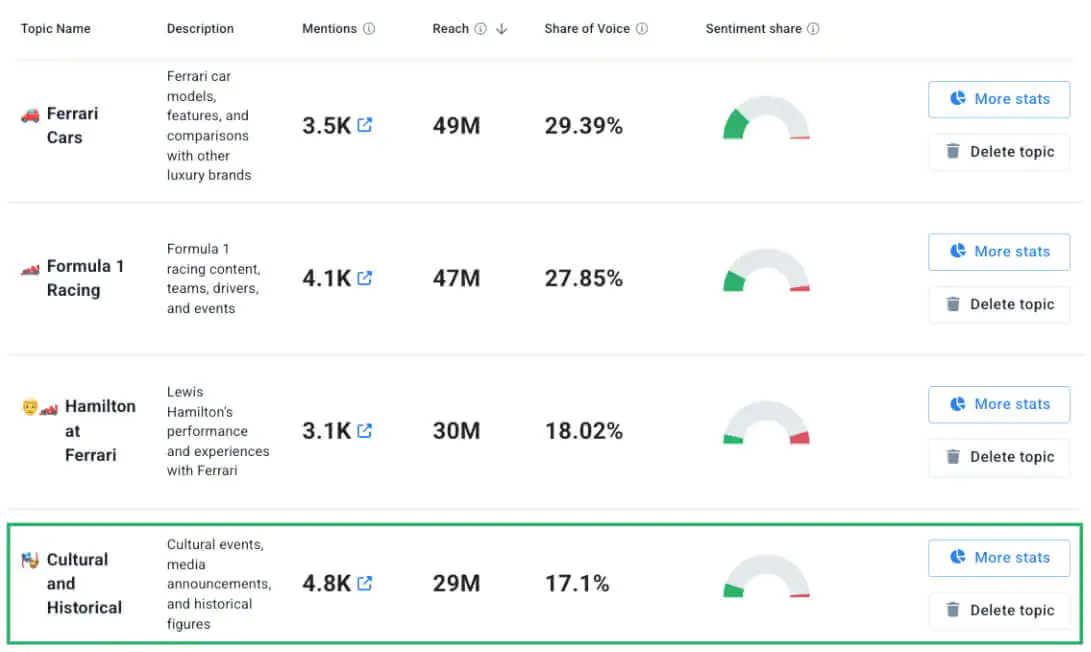
02 You can focus your efforts on the right social media channels
Sentiment analysis also allows you to identify your top social media platforms.
The ability to see and compare your performance on multiple platforms enables you to:
- Understand which campaigns worked well and which didn’t – high engagement doesn’t always mean equally good customer sentiment
- Spot platforms where negative sentiment is a bit too high – it signals a need for a different approach or brand messaging style
- Prioritize resources and adjust strategy for channels that really matter – even the biggest brands usually focus on two or three top channels.

03 Improve customer service
In the age of strong competition, customer satisfaction is one of the most critical elements brands must master to stand out from the crowd.

On the flip side, negative experiences can quickly escalate online, damaging a brand’s reputation almost instantly.
That’s why customer satisfaction analysis on what they post on social media plays a key role here.
By monitoring the tone and emotions behind mentions, comments, customer feedback, and reviews, brands can detect pain points early and address them before they escalate.
Moreover, real-time social media monitoring helps prioritize urgent cases, allowing brands to respond faster and more empathetically.
That can boost customer engagement and increase brand loyalty.
04 Get inspired by competitors
The best social listening tools allow you to set up multiple projects and track both your own and your competitors’ brands.
And that’s a goldmine of inspiration!
By gathering and processing sentiment data on your market rivals, you can quickly uncover what resonates with their audiences – and what falls flat.
This gives you a competitive edge and strategic advantage: you can learn from their successes, avoid repeating mistakes, and spot gaps in the market.
Example?
Well, a few years ago, Apple released the “Crush” campaign to promote its new iPad.
The video presented a hydraulic press crushing various creative tools (like guitars or sculptures), symbolizing that all creativity now fits into an iPad.

Many viewers perceived the ad as disrespectful to art and creativity.
There have been a lot of negative comments about Apple these days!
Samsung quickly recognized the opportunity.
It launched the “Uncrush” campaign, featuring a girl playing the guitar and the message “Creativity cannot be crushed.”

Samsung positioned itself as the brand that truly respects creators – all thanks to listening, understanding, and reacting to the emotional tone of the audience.

Read more: 7 Social Listening Examples
05 Prevent crises
Last but not least, social media sentiment tracking allows you to spot potential brand crises before they fully blow up.
And that’s something you can’t ignore!
In the research conducted by Deloitte, 87% of C-levels have pointed to reputation risk as the most significant risk area.
This figure shows that protecting your brand’s reputation isn’t just about reacting to problems – it’s about actively monitoring early warning signs.
Real-time public sentiment tracking equips you with the ability to detect issues before they escalate.
Lucky us, most of the sentiment analysis tools offer some kind of alerts.
Here’s an example based on the analysis for Booking. I got it emailed when the buzz started:
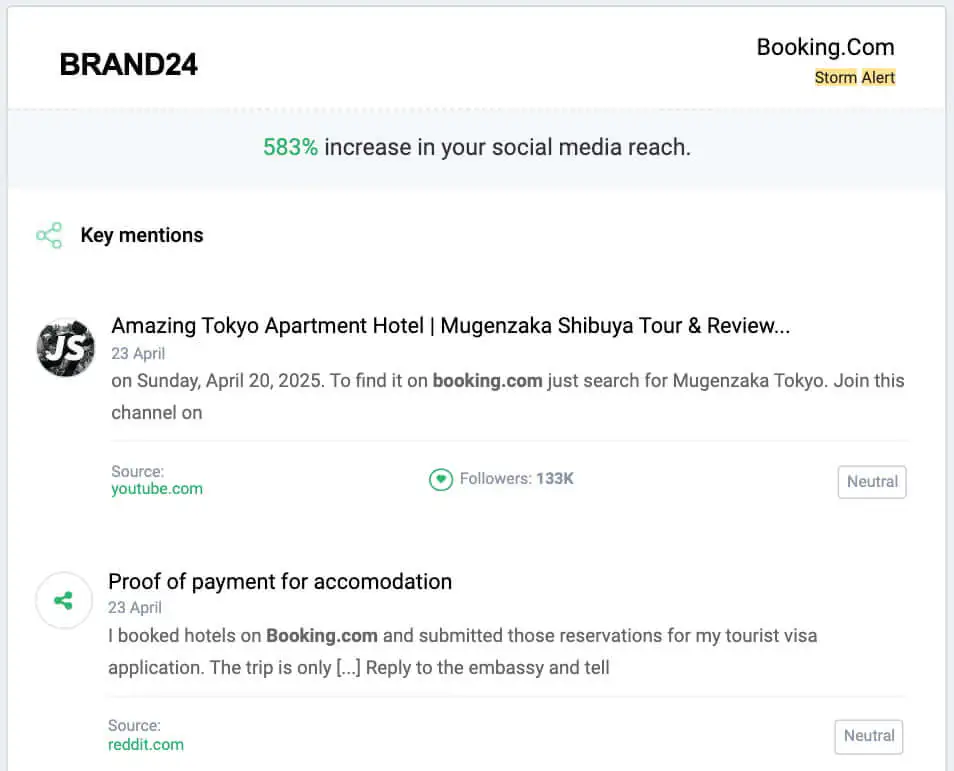
Such alerts are super easy to set up.
How to conduct sentiment analysis for social media?
Now, let’s turn the theory into practice!
Here’s the 5-step guide that will allow you to include social media sentiment analysis into your work routine.
01 Use social media sentiment analysis tools
In the beginning, it might seem that we can do the sentiment analysis on social media manually. However, this would require lots of time and effort.
To be honest, I can’t imagine analyzing each mention and post.
Luckily, we don’t need to do it because (yeah!) we have freaking awesome technology!
Social media sentiment analysis tools monitor all your brand mentions published on multiple social platforms and automatically analyze the emotional tone behind them.
How does it work?
Tools apply natural language processing (NLP) to analyze online mentions and determine the feelings behind the post.
Yeah, sentiment analysis tools are a game-changer. They allow you to sift through the noise and extract valuable insights.
Texts that have similar meanings for humans will also have similar meanings for the sentiment analysis algorithm.
That way, the algorithm can detect synonyms and correctly identify feelings behind the message.
The two most important factors that you should consider when choosing the right social media sentiment analysis tool are:
- The number of monitored platforms – the more, the better
- Insights it can provide – the best tools don’t just show raw, unstructured data but deliver actionable insights, recommendations, and trends

02 Monitor brand mentions regularly
Brand sentiment can change quickly. Even a single TikTok video can skyrocket your reputation. And even one Reddit thread can ruin it.
That’s why sentiment analysis is not a one-time effort but a continuous process.
And that’s why constant media monitoring is a must for brands that take themselves seriously.
The good news is that monitoring social media conversations doesn’t mean you should stare at your sentiment analysis tool 24 hours a day!
Good practices to build your workflow (and not get crazy):
1. Set up smart & automated alerts.
Most of the best sentiment analysis tools allow you to create customized notifications based on a sudden spike in mention volume or an unexpected increase in social media reach.
2. Get a quick overview with the help of AI.
Whenever an unexpected event occurs and you get your notification, it’s necessary to understand what happened as quickly as possible.
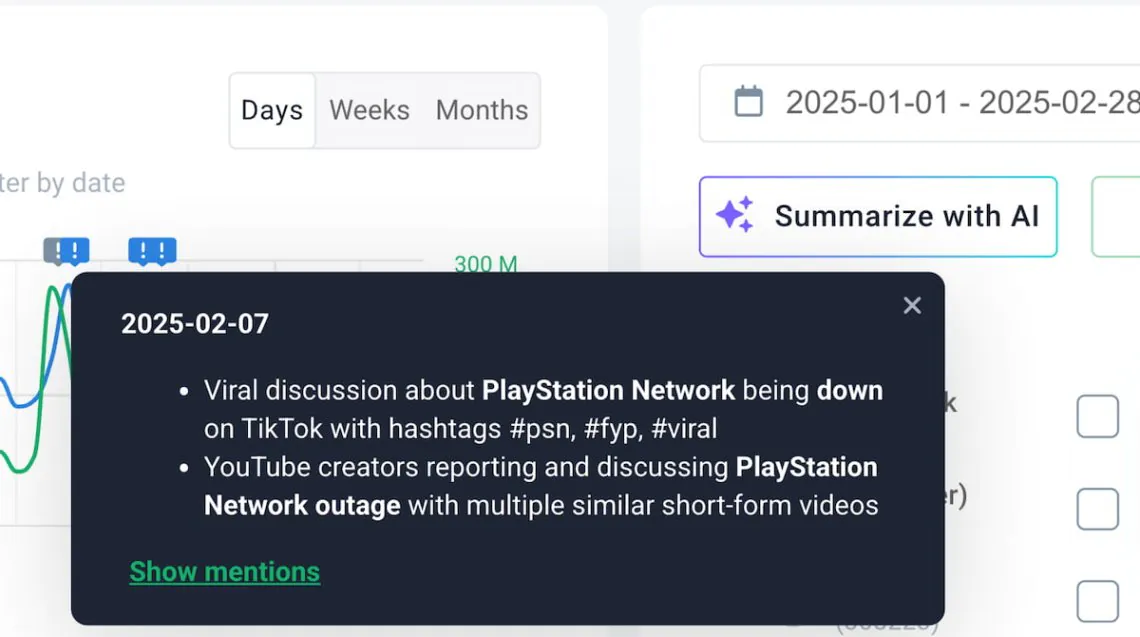
3. Check the most important social media posts.
Not every post has an equal impact on your reputation.
The more influential the profile, the bigger the potential impact on your brand image.
Prioritize mentions from verified accounts, industry leaders, or viral creators, as their opinions can quickly shape public perception.
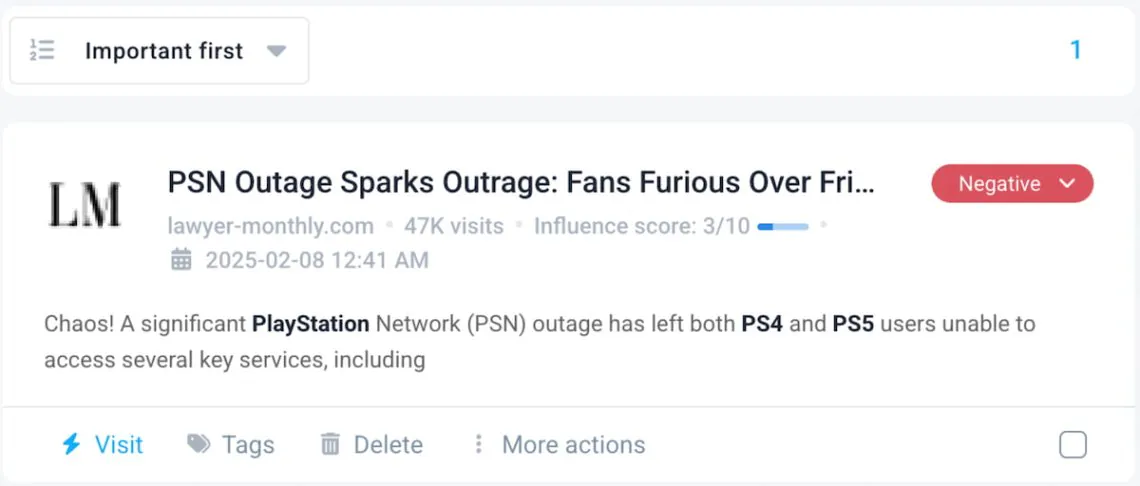
03 Analyze sentiment trends over time
Individual mentions provide important signals, but it’s the overall trends that reveal the full story.
Tracking sentiment over time helps you understand the bigger picture, so how public perception of your brand evolves weekly, monthly, and after major events like product launches or campaigns.
Such sentiment insights give you a lot of valuable information regarding your performance:
- Allow you to identify trends.
For example, a steady increase in positive mentions and sentiment after implementing a new customer service strategy; - Highlight the long-term impact of your marketing strategies.
For example, a successful brand awareness campaign may lead to a lasting increase in positive mentions and overall sentiment across social media platforms - Give you benchmarks for the future.
By understanding how your previous campaigns influenced sentiment, you can set realistic goals and better evaluate the success of your future efforts.
Time for a quick experiment.
Below you can see Red Bull’s sentiment chart:
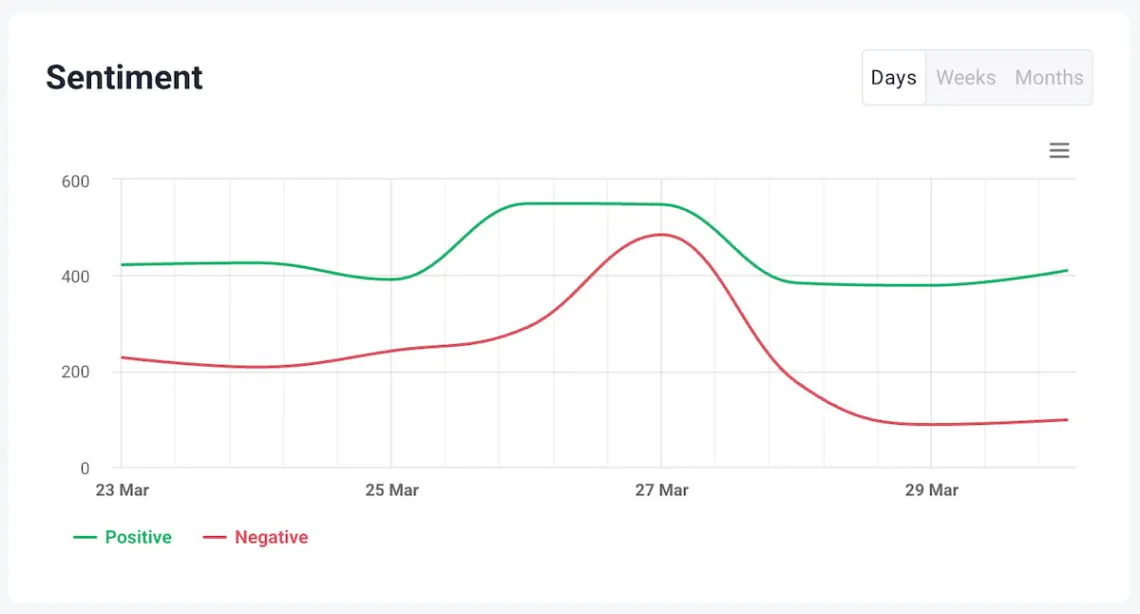
Now, take a look at Red Bull’s sentiment chart for the last four months:

Moreover, the visible spike in positive mentions in late February has skyrocketed Red Bull’s online Presence Score.
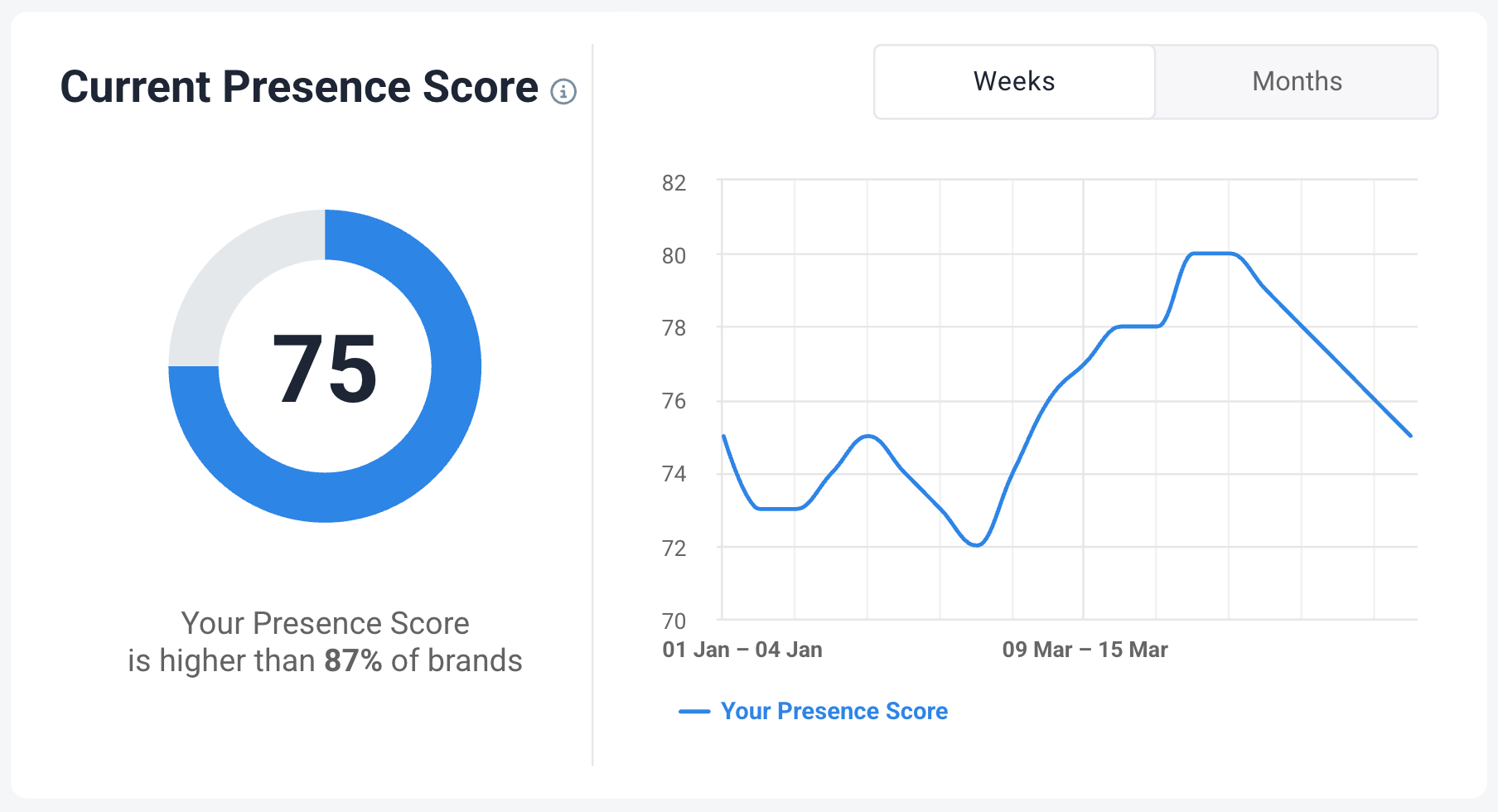
Fine, but what exactly happened then?
We’ll look for an explanation in the next step of social media sentiment analysis, which is…
04 Draw insights and act!
Collecting sentiment data is necessary, but it requires action to truly make an impact.
You must translate them into insights and – ultimately – make actionable decisions!
Because how you act defines your brand’s future.
We can reduce it to the following scheme:
Collect Data -> Draw Insights -> Make Decisions
Here is a sample, practical workflow:
1. Discover what works.
If a specific type of post or campaign generates a lot of positive sentiment – focus on it even more!
Create similar content, invest in similar campaigns, or maximize the impact of existing, successful efforts.
💡 Tip: Use AI!
It can be an extremely helpful feature for drawing insights about brand’s online performance.
A massive increase in Red Bull’s positive sentiment at the beginning of February was driven by two events:
Red Bull Hardline (an extreme mountain biking competition) and the Formula 1 season launch (Red Bull owns an F1 team).

According to AI Insights’ recommendations (I sourced them using Brand24 tool), Red Bull should continue capitalizing on extreme sports success and leverage its Formula 1 connection.

2. Address negative feedback fast.
If you spot negative emotions around a particular topic, product, or service – don’t ignore it.
Find the cause, acknowledge the issue, and fix it if possible.
I quickly investigated Red Bull’s spike in negative words using AI Brand Assistant.
It turned out that the backlash was caused by replacing one Formula 1 driver with another.
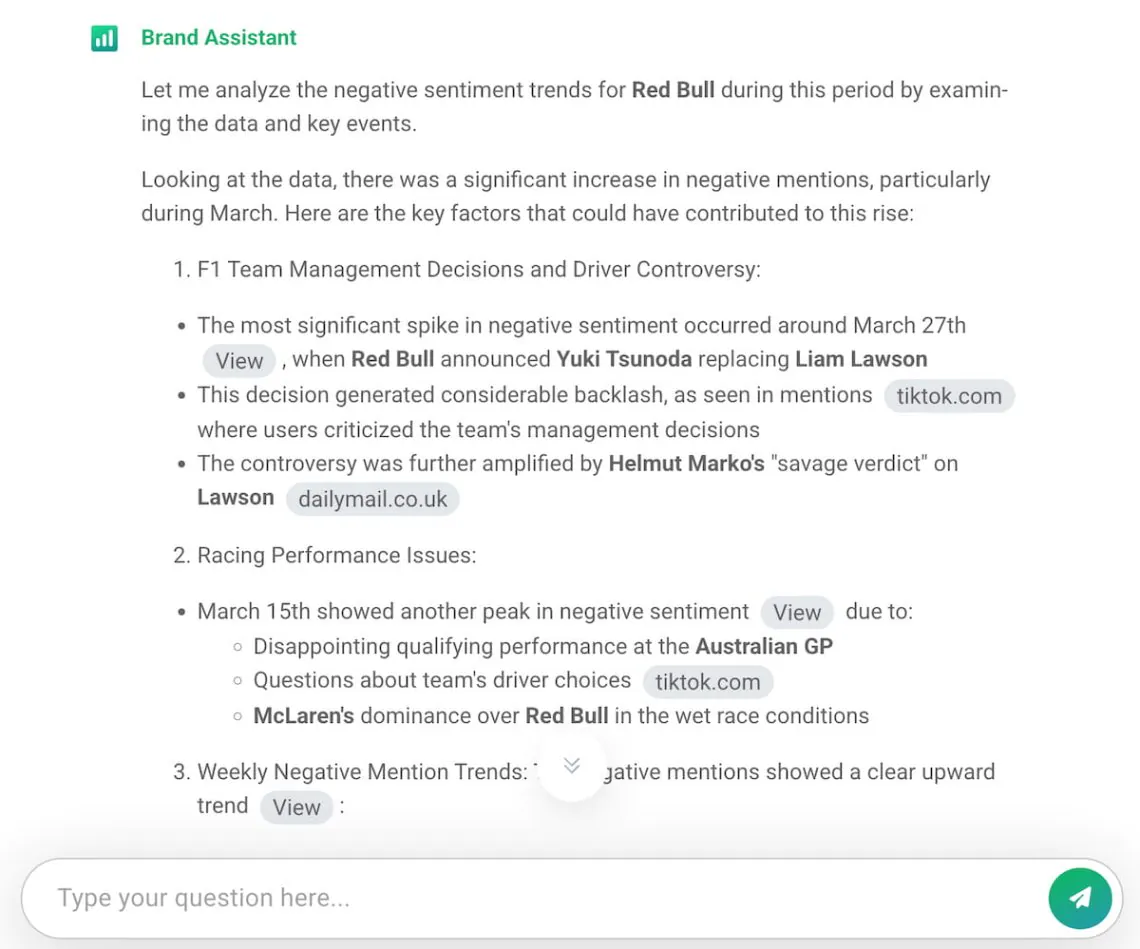
3. Spot new opportunities.
Sometimes, sentiment analysis uncovers unexpected insights.
Maybe your audience is praising a feature you never promoted. Why not build a campaign around it?
05 Report – iterate – repeat
As I told you before, social media sentiment analysis is not a one-and-done task — it’s an ongoing process that requires continuous improvement.
Once you have gathered the data and turned it into insights, it is time to present the results of your work.
You can create a report yourself, but many sentiment analysis tools have a built-in reporting feature.

The most important aspect of reporting analysis is the ability to choose the data you want to include.
You will be able to show exactly the insights you have worked on and the impact your activities had on the key metrics on every platform you are present.
Some good practices to implement:
- Summarize your findings.
Create simple reports that capture sentiment trends and key insights. Highlight what worked, what didn’t, and what requires attention. - Share insights across teams.
Deliver clear, actionable takeaways to your marketing, PR, customer service, and product teams. Equip them to make smarter decisions based on real customer emotions. - Test new strategies based on insights.
Whether it’s adjusting content, changing messaging, or launching new initiatives, sentiment analysis should inspire new experiments. - Measure the impact of changes.
After implementing new actions, monitor how brand sentiment changes. Did positive mentions grow? Did customer satisfaction improve? Treat every campaign and adjustment as a new hypothesis to be tested.
5 Expert tips to improve social media sentiment analysis
To bring this topic to life, I asked Zuza Kumorek, a Social Media Specialist at Brand24, to share her hands-on experience with sentiment analysis.
Zuza works on navigating online conversations every day – from crisis response to community building, and knows how sentiment data translates into real-life strategy.
She says:
According to Zuza, here’s how you should use sentiment analysis for social media:
01 Emotions are data, but only if you notice the texture
What’s the most common sentiment analysis mistake?
Brands take numbers too directly. What matters are patterns of tone – how sarcasm ripples before a storm, how enthusiasm fades into irony, how words repeat slightly out of sync across communities.
When I look at trending topics, I don’t care about reach; I care about the emotional gradients. They tell you what’s alive, what’s burning out, and what’s about to change.
02 Crises begin in the subtext
Can sentiment help prevent a PR crisis?
Before any PR explosion, there’s a whisper of discomfort. Comments that turn brittle, jokes that stop landing, a small cluster of users suddenly colder.
Most brands only react when the headline breaks. The good ones notice the tremor — and adjust the tone before the quake.
Plus, monitoring customer feedback helps address pain points and improve products or services in real-time.
03 Negativity is a free research
How to get meaningful insights from sentiment analysis?
Well, every complaint is a mirror. Not all are accurate, but most reveal what people expected from you and didn’t get.
Don’t chase praise — chase clarity. Read frustration as a form of investment: someone cared enough to object. Their emotion is feedback in its rawest, most useful form.
Social media sentiment analysis provides immediate insights into customer emotions, enabling agile responses.
04 Neutral mentions are also valuable
Should I skip the neutral mentions?
Absolutely not!
Neutral sentiment isn’t absence — it’s potential energy.
The casual “just sharing” or untagged repost is a door left ajar. A small gesture — a reply, a thank-you, a quiet acknowledgment — can flip neutrality into goodwill.
It’s the internet equivalent of eye contact.
05 The best influencers move feelings, not metrics
How influencers shape audience sentiment?
You can buy reach, but not resonance. The most valuable creators are emotional catalysts: they shift the tone of the conversation.
They are not always the loudest.
Sometimes they’re the ones who make a community breathe easier after a long argument.
Find them. Collaborate quietly.
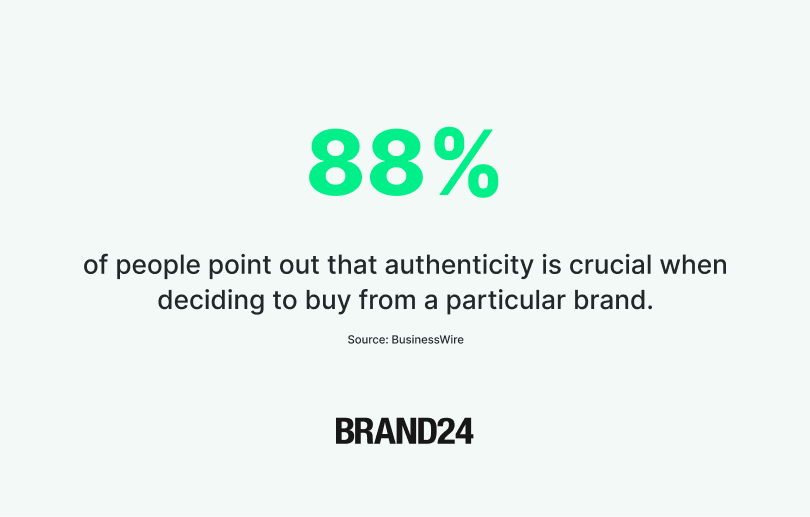
Conclusion
Social media sentiment analysis is a powerful way to understand how people truly feel about your brand.
Instead of focusing only on numbers, it gives you aspect-based sentiment analysis with emotional insights that help you improve your marketing, communication, and product strategy.
Dedicated tools make it easy to track mentions, uncover emotions, and spot opportunities or problems early.
By analyzing various social media platforms, you can find out where your audience is most engaged and where you need to adjust.
Real-time monitoring also strengthens customer service, helping you react before small issues grow into bigger problems.
Also, you don’t need to limit your analysis to only your own sentiment! Observing your competitors can be incredibly inspiring and give you a smart edge in the market.
Tracking trends over time helps you understand the bigger picture, while acting on insights turns data into real results.
In short, smart use of sentiment analysis means smarter, faster, and more human-centered brand decisions.
Final thoughts:
- Use social media sentiment insights to guide your long-term marketing strategies.
- Treat every sudden change in sentiment as a chance to learn and improve.
- Remember that emotions drive most customer decisions.
- Focus on building real, emotional connections with your audience.
- Make social listening a daily habit, not a one-time project.
Start a 14-day free Brand24 trial and discover your social media sentiment right away!
FAQ
Q1: How can I analyze sentiment on social media platforms effectively?
- Define goals.
- Pick a sentiment analysis tool.
- Connect all social platforms.
- Build keyword & topic lists.
- Track trends.
- Act on insights.
Q2: Can sentiment analysis help improve social media marketing strategies?
Yes. Use sentiment to refine messaging, pick the best channels, spot crises, guide product fixes, personalize replies, and measure brand perception. Tie sentiment trends to KPIs (reach, CTR, CSAT, revenue) to prove impact.
Q3: What challenges are there in accurately analyzing social media sentiment?
The most common include: identifying sarcasm, slang, emojis/GIFs, domain jargon, code-switching, multilingual posts, bots, sampling bias, and context loss. Mitigate with custom lexicons, emoji handling, human-in-the-loop QA, and periodic re-training.
Q4: What is a good social media sentiment score?
It depends. A net sentiment (positive−negative) above ~20–30% or a >3:1 positive: negative ratio is generally healthy. Benchmark against your history and competitors; watch spikes and topic-level shifts more than one absolute number.
Q5: Can AI do sentiment analysis?
Yes, for light, ad-hoc classification of short posts. It’s non-deterministic and not ideal for high-volume, real-time, or compliance needs. For scale, use specialized tools.







